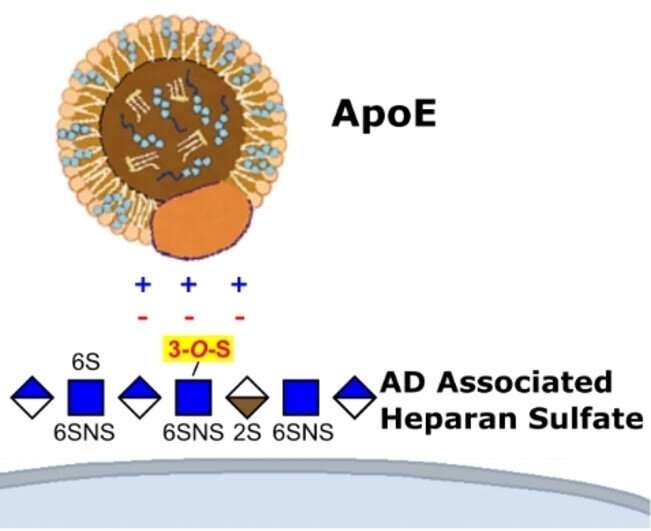This article has been reviewed according to Science X's editorial process and policies. Editors have highlighted the following attributes while ensuring the content's credibility:
fact-checked
peer-reviewed publication
trusted source
proofread
Researchers find new potential drug target for Alzheimer's disease

Chunyu Wang, Ph.D., professor of biological sciences at Rensselaer Polytechnic Institute, has added to his body of research on Alzheimer's disease with significant findings now published in Angewandte Chemie.
Together with his team, which includes first author and Rensselaer doctoral student Dylan Mah, Wang performed the most comprehensive study to date of the interactions between ApoE, or Apolipoprotein E, and heparan sulfate (HS). ApoE is a protein that combines with fats to transport cholesterol throughout the body. Heparan sulfate is a sugar molecule present on cell surfaces that plays a key role in cellular communication. A variant of ApoE, ApoE4, is the most significant genetic risk for late-onset Alzheimer's disease.
"It's tremendously interesting to explore why ApoE4 can increase Alzheimer's risk," said Wang.
Wang's team investigated not only ApoE4, but ApoE3, the most common ApoE genotype and two protective isoform ApoE2 and ApoE Christchurch, as well. They discovered that the 3-O-sulfo (3-O-S) modification of HS was important for ApoE/HS interactions. All isoforms of ApoE recognized 3-O-S, but the differences in their strength of interactions correlated with Alzheimer's disease risk.
"In the initial glycan array experiment, which is basically a chip with a collection of different heparan sulfate oligosaccharide on it, we flowed ApoE over it," said Mah. "We were quite surprised to see that it had a binding pattern that looked very similar to Tau protein. It binds very well to the 3-O sulfated structures."
Tau protein is implicated in many neurogenerative diseases, including Alzheimer's.
The team's findings point to a new potential drug target to slow the progress of the disease: the enzymes responsible for sulfation called heparan sulfate 3-O transferases.
Next, the team plans to take a deeper look at ApoE/HS interaction by developing a 3D structural model of ApoE-HS interaction and examining this interaction in cell cultures and animal models.
"Alzheimer's disease is very complex with so many aspects," said Wang. "The more I study it, the more interesting it gets."
"Ultimately, we want to prevent or mitigate enough of the symptoms of Alzheimer's disease so people can continue to live independently," added Mah. "Understanding how the disease works on a molecular basis is really critical to finding new treatments."
"As our population ages, Dr. Wang's research on Alzheimer's disease is increasingly significant," said Deepak Vashishth, director of Rensselaer's Shirley Ann Jackson, Ph.D. Center for Biotechnology and Interdisciplinary Studies, of which Wang is a member. "The identification of a new potential drug target to fight this progressive disease is enormously exciting for not only the six million patients in the United States, but for their families and caregivers."
More information: Dylan Mah et al, Apolipoprotein E Recognizes Alzheimer's Disease Associated 3‐ O Sulfation of Heparan Sulfate, Angewandte Chemie International Edition (2023). DOI: 10.1002/anie.202212636





















